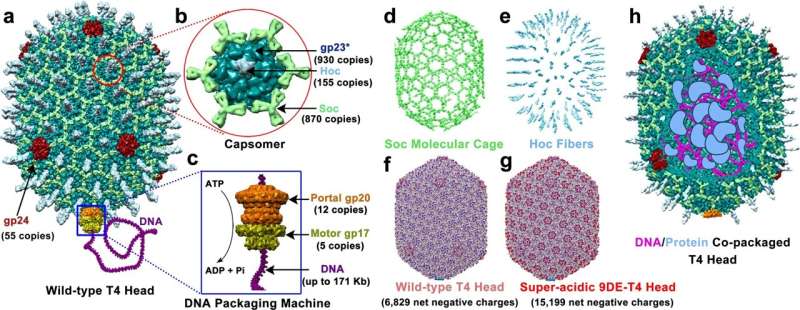May 31, 2023 report
This article has been reviewed according to Science X's editorial process and policies. Editors have highlighted the following attributes while ensuring the content's credibility:
fact-checked
peer-reviewed publication
trusted source
proofread
Engineering the bacteriophage T4 to serve as a vector for molecular repair

A team of medical scientists at The Catholic University of America, in Washington, D.C., working with a colleague from Purdue University, has developed a way to engineer the bacteriophage T4 to serve as a vector for molecular repair. The study is reported in the journal Nature Communications.
Prior research has shown that many human ailments arise due to genetic mutations: cystic fibrosis, Down syndrome, sickle cell disease and hemophilia are just a few. Logic suggests that correcting such genetic mutations could cure these diseases. So researchers have been working toward developing gene editing tools that will allow for safe editing of genes.
One of the most promising is the CRISPR gene editing system. In this new effort, the research team took a more general approach to solving the problem by working to develop a vector that could be used to carry different kinds of tools to targeted cells and then enter them to allow for healing work to commence.
The vector is based on the T4 bacteriophage, a virus that is known to infect E. coli bacteria. It was chosen because of its safety record and large size, making it a suitable candidate for carrying relatively large-sized payloads. The most recent work with the bacteriophage has involved giving the virus a coating that allows it to more easily slip through lipid cell walls.
They also developed a CRISPR system that could be easily used with T4 and engineered the virus to optimize its ability to carry a large payload, which can include (in addition to a CRISPR system) large amounts of DNA, proteins, RNA and biomolecules.
Thus far, the team has tested their system on specialized human cells in a petri dish and have found that it has worked as hoped. They next plan to test it with primary and embryonic cells and then move on to testing in mouse models. The ultimate goal, of course, is test it in humans, where they hope it could cure a large variety of diseases.
More information: Jingen Zhu et al, Design of bacteriophage T4-based artificial viral vectors for human genome remodeling, Nature Communications (2023). DOI: 10.1038/s41467-023-38364-1
Journal information: Nature Communications
© 2023 Science X Network





















